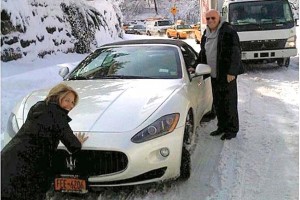
Katie Couric lends a hand moving media mogul Barry Diller's Maserati out of a snowdrift in Central Park.
Snowstorms have a decidedly democratic streak, and so, when media mogul Barry Diller found himself stuck in a snowdrift in New York’s Central Park, he got a helping hand from another celeb slogging through the storm, CBS New talking head Katie Couric.
Whether Diller offered Couric a tip – or a ride – is uncertain, but it was likely the latter considering the high demand for the Maserati GranTurismo Convertible he was driving.
After years of struggling to make inroads in the normally luxury-friendly U.S. market, the Italian automaker is finally gaining some traction, with or without Couric’s help. While the overall luxury car market rebounded by 15% last year, Maserati sales jumped 49% — then delivered another 13% increase in January.
“We had a good year,” suggested an understated Mark McNabb, the industry veteran who signed on as Maserati’s top American executive, last year. The goal going into 2010, he said, was simply to “maintain the pace” with the rest of the luxury market, and perhaps pick up some incremental volume with the launch of the GT Convertible. The new ragtop wildly exceeded expectations.
That’s good news for the nearly century-old maker, which some thought might be forced to abandon U.S. shores, as it had done back in 1990. Back then, Maserati was struggling after years of mis-management under the helm of one-time racer Alessandro de Tomaso, who had taken control in 1975.
Things began to turn around, in 1993, when Fiat SpA bought out the company, which had once been a dominant force in the motor sports world, with drivers like Juan Manuel Fangio, Phil Hill and Stirling Moss piloting the trident logo to a string of legendary victories.
Fiat has invested billions in the venture, rebuilding Maserati’s factory, in Modena, Italy, and calling on the resource of two other high-line brands, Alfa-Romeo and Ferrari, the latter providing key componentry for many recent Maserati models.
But success has taken longer than anticipated. A decade ago, the maker was projecting global sales of as much as 10,000 cars a year, with the U.S. seen as one of the lead markets. So far, Maserati hasn’t come close, though the meltdown on Wall Street certainly didn’t help – generating an uncharacteristically severe dip in demand for all luxury automotive brands.
So, generating 1,897 American sales, last year, was a significant improvement, especially considering the GranTurismo Convertible only reached U.S. showrooms in March.
That may actually underscore the breadth of the turnaround, suggests McNabb, who inherited some serious problems, including a huge backlog of old models that dealers hadn’t been able to sell. Fixing that “serious inventory imbalance” without record incentives was a first step. Holding down inventories, now that demand is building, is another challenge.
“You start doing a lot of things wrong when you let your inventories get out of balance,” he warns.
Maserati would seem to be especially well positioned, going forward considering its parent company is itself returning to the U.S. after a nearly three-decade absence. And Fiat CEO Sergio Marchionne is overseeing that move in his dual role as chief executive of the company’s new U.S. partner, Chrysler.
The Fiat brand is just re-launching with the debut of the pint-sized Cinquecento – the Fiat 500 to American buyers. Meanwhile, Marchionne has confirmed that the Alfa-Romeo brand will return, as well. Alfa tested American waters two years ago with the limited-edition 8C supercar, which was an almost instant sell-out.
But questions remain about how the brand will move forward when it introduces the smaller, more affordable model Marchionne hints will follow.
The 8C was sold through Maserati’s distribution network. But McNabb says that it has not yet been determined whether that route will be taken by Alfa going forward. It could, instead, pair up with Fiat’s new dealer network or set up a distribution channel of its own.
One concern observers raise is whether Fiat’s attention will be diverted away from Maserati, which has proven the critical role that new product plays. The maker’s line-up is thin, especially considering the depth of what some of its competitors offer. For the moment, there are no stated plans to bring the European Cambiocorsa model to the States, suggests McNabb. But sources say more may soon be in the offering.
After years of trying, Maserati is convinced it can keep the newfound momentum going, but simply pointing to the success of the past year won’t be enough on its own.
